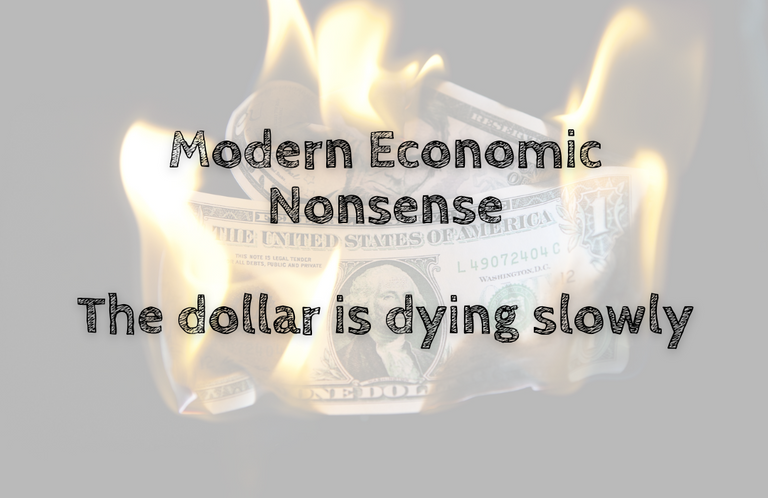
The greenback is no longer the world’s reserve currency ⚰️, and this is becoming evident by the day. Emerging economies are moving toward reducing their exposure to the dollar — some are even willing to pay a heavy price. The nations that make up the majority of the world economy have grown tired of being at the mercy of the U.S., which has used its position as a global monetary superpower to siphon off wealth from other nations in exchange for cheap credit and token assets such as stocks in American companies. It has been over 200 years since England abandoned the gold standard and introduced paper money as a primary means of financial transaction. Since then, there have been numerous attempts to revert back to gold-based money or some variation thereof; however, none has succeeded so far. Today we live in a digital world where information is stored in bytes instead of gold bars, tokens are more relevant than coins, and digital payment systems like PayPal have replaced leather purses filled with gold coins as an instrument to pay for goods and services. This raises another question: Will fiat currencies survive another 200 years? Hint: probably not.
The end of an era?
The first thing that comes to mind when discussing the end of the era of fiat currency is the end of the era of the U.S. dollar as the world’s primary reserve currency. The dollar has reigned supreme since the 1940s when the U.S. abandoned the gold standard and introduced the Bretton Woods system. The dollar has been on a downward trajectory ever since the financial crisis exploded in 2007-2008. The crisis has been the catalyst that has accelerated the dollar’s demise. The crisis has also exposed the flaws of the financial system. The response to the crisis, which involved flooding the economy with cheap money through low-interest-rate policies, has created even more instabilities in the system with multiple levels of bubble within the financial system everywhere. The dollar’s fall has been the most spectacular, and it has been hastened by the U.S. administration’s imposition of various trade tariffs and sanctions on other countries. In 2022, with many chaotic world of war, health crises, money crises, debts crises, food crises, climate crises, ... you can add more in the coming years, can the dollar be trustable anymore to weather down the multiple levels of crises?
FUD: Fear, uncertainty, and doubt
😱 Fear: As other central banks acquire more gold, their gold reserves increase. This increases their demand for gold, thus driving up the price of gold. The ever-increasing price of gold is a constant reminder of the fragility of fiat currencies and the impending doom of the dollar as the world’s primary reserve currency. However, going back to the gold standard is going backward in history. Digital currency is preferable to move past forward.
🤯 Uncertainty: Uncertainty is inherent in the financial system. The system is very complex, and its failure is inevitable.
🤯 Doubt: As the world’s financial system becomes more fragile and appears more likely to fail, the demand for gold increases. This puts pressure on the dollar and hastens its demise as the world’s primary reserve currency.
The rise of digital currency
The world is moving toward a cashless society, and this is another ominous sign for the dollar. More than 60% of transactions are done electronically, and some people are even willing to move entirely away from cash. People are increasingly relying on electronic payment systems to buy goods and services. This transition from cash to electronic money has given rise to digital currency, which is neither backed by gold nor guaranteed by a government. Some of these digital currencies have become very popular, and their usage is growing fast. These digital currencies are decentralized and use peer-to-peer systems to make transactions. They are also used in Decentralized Autonomous Organizations (DAOs) to raise the company's funds. This revolutionary development will likely undermine the future of fiat currencies and hasten the dollar’s demise.
Blockchain technology is the future
Cryptocurrencies are just the tip of the iceberg. They have been around for less than a decade, and their popularity is growing fast. It is only a matter of time before they become mainstream and replace fiat currencies altogether. This is because blockchain technology, which powers cryptocurrencies, is becoming more robust and scalable. Blockchain is a distributed ledger technology that is immutable (cannot be tampered with), auditable, and transparent. It has the potential to transform the global economy in a decade or two. It is already being used in many sectors: food safety, supply chain, financial services, healthcare, real estate, and governance. Governments and financial institutions are exploring how they can use blockchain in their operations. It is only a matter of time before it becomes the standard for financial transactions. When that happens, fiat currencies will become redundant.
Conclusion
The dollar is dying slowly, and this is evident from the increasing demand for digital payment systems and the adoption of digital currency. Emerging economies are moving fast toward reducing their exposure to the dollar. Some are even willing to pay a heavy price for it — and they are likely to succeed. The dollar is the world’s primary reserve currency, but it is being challenged by the rise of other currencies. The dollar has lost its value and will inevitably be replaced by another currency as the main store of value.

Note: Cross-references of this article have been created by the author and have been cross-referenced on multiple platforms here. Please reference the resources and credits here. Reach out to the authors if you have any questions.
Posted Using LeoFinance Beta